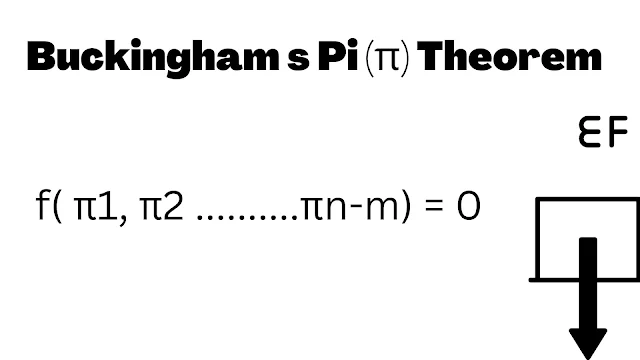Buckingham Pi theorem states that the number of dimensionless groups is equal to the number of variables minus the number of fundamental dimensions.
If there are n variables, Q1, Q2 ......Qn affecting a given physical process, the functional relationship between them can be written as
\[f ( Q1, Q2 ......Qn) = 0\]
If there are m fundamental dimensions required to define the dimensions of Q1, Q2 ......Qn, then n - m dimensions groups (π1, π2 .....πn-m), and the functional relationship between them can be written as
{tocify} $title={Table of Contents}
\[f( π1, π2 ..........πn-m)\ = 0\]
The groups π1, π2, etc. must be independent of each other.
With the help of Buckingham π theorem, it is possible to obtain the dimensionless groups more easily than by solving the simultaneous equations for the exponents/indices.
Buckingham Pi Theorem Derivation
Select m of the original variable to form what is called a recurring set.
The dependent variable, which is the variable that depends upon the other variables, should not be included in the recurring set.
Any set m of the variables may be selected with the following provisions.
Each of the fundamental/basic dimensions must appear in at least one of the m variables.
Some or all of the variables within the recurring set must not form a dimensionless group.
Take each of the remaining n -m variables on its own and form it into a dimensionless group by combining it with one or more members of the recurring set. In this manner, the n - m dimensionless groups are formed.
The following problem will give a clear idea regarding the procedure of obtaining dimensionless groups with the help of Buckingham's Pi Theorem.
The Buckingham Pi theorem used for
Use of Buckingham Pi theorem for dimensional analysis.
The relationship between the variables affecting the pressure drop for the flow of a fluid in a pipe may be written as
\[f (ΔP, d, l, u, ρ, μ)\ = \ 0 -------1.0\]
In this equation (1.0) there are six variables and three fundamental dimensions ( mass, length, time)
Therefore, the number of dimensionless groups = 6 - 3 = 3.
The recurring set must contain three variables that cannot form a dimensionless group.
(i) l and d cannot be selected as they can be themselves formed into the dimensionless group l/d.
(ii) ΔP, ρ, and u cannot be selected as they can be formed into dimensionless group ΔP/ρu2.
(iii) ΔP is the affected variable so it cannot be included in the recurring set.
If we select the variables d, u, ρ as the recurring set, this set fulfills all the above conditions.
Dimensionally:
\[d = L\]
\[u = LӨ-¹\]
\[ρ = ML¯3\]
Each of the dimensions M, L, and Ө can then be obtained in terms of the variables d, u, and ρ.
Therefore,
\[L = D\]
\[M = ρD³\]
\[Ө = Du¯¹\]
Thus, the three dimensionless groups are formed by taking each of the remaining variables ΔP, l, and μ in turn.
(i) Taking ΔP to form one dimensionless group, ΔP has dimensions ML¯¹ Ө² is therefore dimensionless.
Therefore, group π1 is
π1 = ΔP (ρD³)¯¹ (D) (Du¯¹)²
= ΔP/ρu².... first group
(ii) Taking l, l has dimensions is L.
l. L ¯¹ is therefore dimensionless, therefore, group π2 is
π2 = l (D)¯¹ = l/D ..... second group
(iii) Taking μ, μ has dimensions ML¯¹Ө¯¹
μ M¯¹L T is therefore dimensionless. Therefore, group π3 is
π3 = μ(ρ D³)¯¹ ( D ) (Du¯¹)
= μ/Duρ .... Third group
Hence, f ( ΔP/ρu², l/D, μ/Duρ) = 0 or
ΔP/ρu² = f( l/D, Duρ/μ)
μ/Duρ is arbitrarily inverted since the Reynolds number is usually expressed in the form μ/Duρ.
Take these Notes is, Orginal Sources: Unit Operations-II, KA Gavhane

